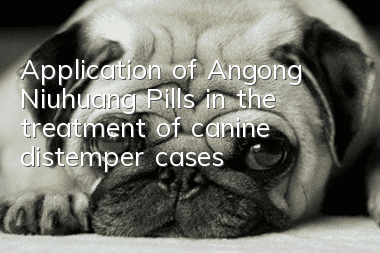Application of Angong Niuhuang Pills in the treatment of canine distemper cases

The visiting husky is a 5-month-old male dog who has not received vaccinations. The owner's friend has adopted him for three months. I have developed cough symptoms in the past two days, but my appetite and bowel movements are normal. The weight is 9.2 kg, the body temperature is 40.3°C, the heart rate is 130 beats per minute, the respiratory rate is 55 times per minute, and the body condition is thin. His mental condition is fair, his nose is dry, there is thick nasal discharge in his nostrils, and his cough is irritating. The CDV test was positive, and the X-ray revealed thickening of the lung markings (see picture), but the stool examination was normal.
1. Case introduction
The patient is a husky dog, male, 5 months old, and has not received vaccinations. It has been three months since the patient was adopted by a friend. The patient has had a cough for the past two days, but his appetite is normal and his bowel and bladder conditions are basically normal.
2. Clinical examination, diagnosis and treatment
The body weight is 9.2kg, the body temperature is 40.3℃, the heart rate is 130 beats/minute, the breathing rate is 55 times/minute, and the body is relatively thin. He was in good mental condition, but had a dry nose and thick nasal discharge, which was easily triggered by coughing, and was positive for CDV. After X-ray examination, the lung texture was thickened and the stool was normal. The main parameters of blood routine and electrolytes are detailed in the table below.
Project
Result
Reference value
Project
Result
Reference value
WBC
1.6-16.9
HCT
2.37-55
LYM#
< p>4.7-5.1Na
134.
144-160
RBC
0
5-8.5
Cl
105
109-122
Sick Dog
X -Light images show lung infection
X-ray images show lung infection
3. Treatment
Treatment principles: antiviral, antibacterial, supportive and symptomatic treat.
Day 1
The dosage of ceftriaxone is 50 mg per 50 kg of body weight, injected subcutaneously, and used twice a day.
Aminophylline is injected subcutaneously every day at a dose of 10 mg per kilogram of body weight, twice each time.
Inject 1ml of amlinbarbital, subcutaneously, twice a day.
Use a mixed intravenous infusion method to infuse the patient with 150 ml of normal saline, which contains 50 mg/kg of vitamin C, 10 mg/kg of inosine, 10 mg of ATP and 50 IU of coenzyme A. In addition, 20 ml of 50% glucose was added.
5. 1 Angong Niuhuang Pill, once a day.
Mix 1 vial of gentamicin, half a vial of dexamethasone and half a vial of aminophyllineAdd an appropriate amount of water and atomize through the atomizer for 20 minutes.
Day 2
The patient was eating and drinking normally at home, but coughed 5-6 times at night and had a somewhat soft bowel movement in the morning.
Body temperature: 40.0℃, the treatment plan is the same as the first day.
Day 3
After returning home, the patient stated that he was in good health and had taken some dog food and water, but had a slight cough at night.
The treatment plan was the same as the next day, and the body temperature was 39.4°C. During the treatment period, the condition remained stable and patients were advised to drink water in a timely manner.
Day 4
Did not come to the hospital for treatment
Day 5
The patient reported that he did not feel unwell when he went home the night before and slept at night There was no cough at all. But last night I started having a severe cough and loose stools.
The animal had a body temperature of 39.8°C, a heart rate of 140 beats/minute, respirations of 50 breaths/minute, a thick nasal discharge, and no canine parvovirus (CPV-) was detected in the CBC and electrolyte tests. , the main indicators are as follows:
Project
Results
Reference value
Project
Results
Reference value
WBC
0
6-16.9
K
1.5-5.8< /p>
LYM#
1.7-5.1
Na
148
144-160
RBC
69
5-8.5
Cl
114
109-122
HCT
36
37-55
PH
4.32-7.42
In the third Tian's treatment plan added Kechuanning oral medicine, one pill each time, twice a day; 654-25 mg subcutaneous injection; and Feixinkang oral medicine, one pill each time, twice a day.
Day 6
The patient reported that he was in good health after returning home, his stool was slightly soft, and his appetite was good, but he coughed 3-4 times at night.
The patient's temperature was 39.0°C and he had a slight runny nose, but he was in good spirits. The doctor continued the treatment plan on day four.
Day 7
The patient said that he was in good health after returning home, but he coughed 4-5 times at night. In terms of stool, it was a little soft last night, but it has returned to normal this morning, and I eat normally in the morning.
The patient's temperature was 39.0, no obvious murmur was heard during auscultation of breathing, and the treatment was the same as the previous day.
After treatment on the same day and discussion with the owner, both parties decided to take the animal home for further treatment. The treatment options are as follows:
Take half an Angong Niuhuang Pill orally once a day for five consecutive days.
Take one tablet twice daily for five days. Each tablet contains 25 mg of amoxicillin and clavulanate potassium.
3. Take Lung Xin Kang, one pill at a time, twice a day for a total of five days.
We called back a week later and found that the dog had recovered and was in good condition.
IV. Summary
Canine distemper is an acute and highly contagious viral disease caused by canine distemper virus. Clinical manifestations include biphasic fever, respiratory and/or pneumonia, gastrointestinal inflammation, leukopenia, neurological symptoms, and thickened footpads. The disease has a high mortality rate and may cause sequelae.
Angong Niuhuang Pill is a medicine that has the functions of clearing heat, detoxifying, resuscitating and resuscitating, and can be used to treat encephalitis, meningitis, toxic encephalopathy, cerebral hemorrhage, sepsis and other diseases. This drug is also effective in treating high fever and related symptoms caused by canine distemper. It mainly contains bezoar, turmeric, rhinoceros horn, skullcap, coptis, realgar, gardenia, cinnabar, borneol, musk, pearl and other ingredients.
In addition to conventional antibacterial and anti-inflammatory treatment, we also used Angong Niuhuang Pills to treat canine distemper virus and related symptoms caused by this case. This approach was very successful and may provide a reference for future treatment of canine distemper.
Extended content overview of "Application of Angong Niuhuang Pills in the Treatment of Canine Distemper Cases":Angong Niuhuang Pills is a traditional Chinese medicine preparation that is often used to treat Various diseases, including canine distemper. This preparation is composed of a variety of natural herbs, which can promote the circulation of qi and blood in the dog's body, enhance physical fitness, improve immunity, and help resist various pathogenic bacteria. Canine distemper is a highly contagious disease caused by the canine distemper virus that severely damages a dog's health and immune system. Common symptoms include high fever, vomiting, diarrhea, cough, runny nose, ophthalmia, etc. If left untreated, canine distemper can lead to the death of your dog. In the treatment of canine distemper, Angong Niuhuang Pills can play a certain auxiliary role. For example, it can help enhance the dog's immunity, reduce the severity of the disease, promote the dog's metabolism, and accelerate the dog's recovery. In addition, Angong Niuhuang Pills have anti-inflammatory, detoxifying, anti-viral and other pharmacological effects, which can effectively inhibit the reproduction of viruses and reduce the pain of the disease. However, it should be noted that Angong Niuhuang Pills cannot completely cure canine distemper. Comprehensive treatment measures should be adopted, including the use of appropriate antibiotics and viral inhibitors, and appropriate supportive treatment to ensure that the dog's body receives adequate nutrition and rest. At the same time, strict isolation and disinfection must be carried out to prevent the spread of the virus.
- Bichon Frize training tips, poop shovelers should keep them in mind!
- How to keep dogs away from body odor
- Four ways to make your Pitbull strong and powerful, tips for training Pitbulls that novices must read!
- How to deal with corneal inflammation in dogs
- Reasons for Tibetan Mastiff hair loss and common sense of care
- What food is better for Teddy to eat during menstruation?
- Which one is better, Golden Retriever or Chow Chow?
- How to treat a German Pinscher with canine distemper?
- Dog otitis externa symptoms and treatments
- How to heal a dog’s intestinal obstruction on its own



